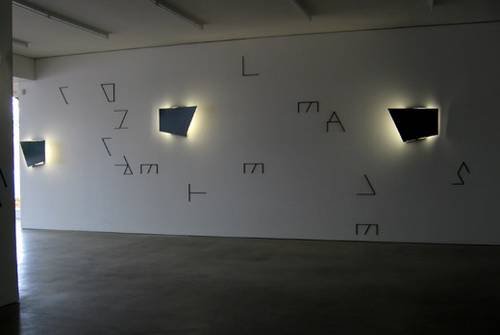Martin Boyce
dal 27/10/2006 al 1/12/2006
Segnalato da
27/10/2006
Martin Boyce
Johnen Galerie, Berlin
We Are the Breeze

We Are the Breeze
In many respects, the spectacular 1950s vacation villa that Michelangelo Antonioni uses in “Zabriskie Point" (1970) to represent the culmination of his film’s journey exemplifies the artistic strategy of Martin Boyce. In accordance with its role in the film, the fantastic house vividly symbolizes an age and its cultural ethos through only a few characteristic architectonic elements. By giving them their particular form, the director imbues these elements with the power to destroy the ideals of the period. In an explosion during the film’s climactic scene, Antonioni gleefully deconstructs this symbol into its individual components. Boyce designs his room installations in similar fashion, in particular citing the 1950s as a transitional period. During this time, the uncritical, naive euphoria for the future that first coalesced in the postwar period and which Antonioni so deeply despised gradually became confronted with the insight that modern utopias had failed.
However Martin Boyce does not try to settle accounts. He utilizes emblematic designs from the period, so-called “classics," and shatters their worn-out originals by combining the fragments in new ways or creating copies of them with similar, often inferior materials. Boyce confronts these elements with perfectly produced citations of individual, isolated aspects from the language of architecture and design. For passersby, the rectangular glass-curtain facade of a typical high-rise seems like a grid of vertical and diagonal lines. This motif appears in Boyce’s works in an almost baroque integration of different sign systems and variations, for example as patterns in his fence-and-gate works; perforations in his ventilation grating; a basic component of wall paintings and penmanship; or as the wire mesh of trashcan objects, which in turn refer directly back to the high-rise.
For his exhibition “We Are the Breeze" Boyce constructs an imaginary landscape, the archetype of a desolate space between park and lobby. With allusions to film sets, Boyce situates just enough clues towards an intuitive recognition within the interplay of few, but crucial motifs. For example, one of his objects, the reminiscence of a telephone booth, contributes to such a relaxed definition of public space. At the same time, in the age of the private cell phone, the phone booth serves as a symbol for its own disappearance. Boyce’s citations are like a returning ghost, condensations of the collective memory. Rather than serve as critique, they evoke melancholy recollections linked to their originals. Boyce is less interested in the failure of their central ideas than in their continuing potential and the question of whether these earlier ideas and ideals still remain relevant for us today.
For his Artforum Berlin 2005 presentation Martin Boyce converts an old concrete ping-pong table into the model of a park. Boyce’s work is generally characterized by the use of everyday and, at first glance, familiar objects, which through alterations become new objects with often unfamiliar meanings. In this manner and through rather few changes, a ping-pong becomes a model of that which it represents. Table tennis rackets become trees; the netting becomes wire fences and ashtrays become trashcans. The materials used underscore the change in scale and the distorting interaction between sports equipment and a table model.
Public spaces, which are “furnished" with planters, benches and playground equipment, illustrate the archetypical failure of post-war city-building, allowing this failure to come to life before our eyes. In collective memory, these spaces are characterized by the transformation from use to abandon, from functionality to destruction. With the ping-pong table and the staging of the space, Martin Boyce alludes to these spaces of urban life. However, in doing so he is not interested in its failure, but rather its utopian potential.
Boyce searches for a vision of the psychology of these landscapes and for the character of the objects that determine them. The model of the park, the ping-pong table, references to this architecture and conveys a view onto the scenery of these landscapes. They appear in fragments as a memory. In their interaction as designed by Boyce, they occupy their place within just one of many possible constellations. Indeed, alongside apparent rawness and brutality and from among countless other constellations, there emerges the one possibility that these places could function if the appropriate situation and participants encountered one another at the right moment.
Image: We Are The Breeze (Concrete Leaves), 2006, brass, metal, lacquered, neon, 310 x 795 cm
Johnen Galerie
Schillingstr. 31 10179 Berlin



